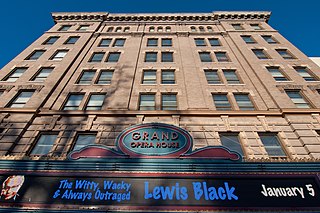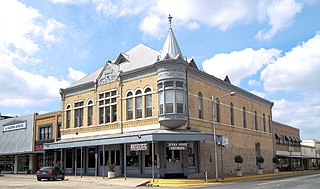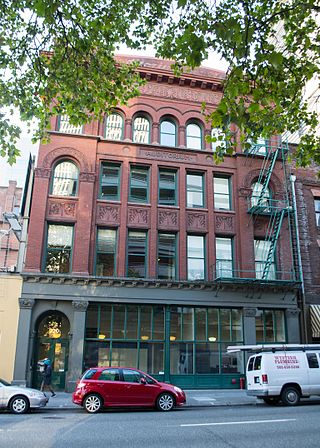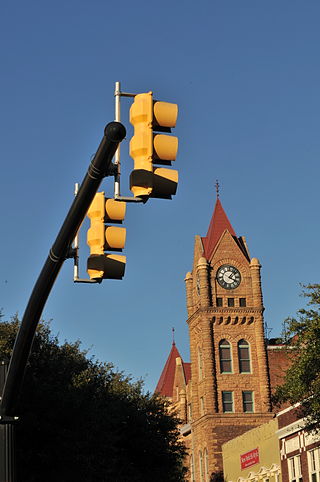
St. Luke's United Methodist Church, also known as St. Luke's Methodist and as St. Luke's United Methodist, is a historic Richardsonian Romanesque-style church located at 1199 Main Street in Dubuque, Iowa. It was individually listed on the National Register of Historic Places in 1998, and as a contributing property in the Upper Main Street Historic District in 2005. It is part of the Iowa Conference of the United Methodist Church.

The Dubuque County Courthouse is located on Central Avenue, between 7th and 8th Streets, in Dubuque, Iowa, United States. The current structure was built from 1891 to 1893 to replace an earlier building. These are believed to be the only two structures to house the county courts and administrative offices.

The Detroit Opera House is an ornate opera house located at 1526 Broadway Street in Downtown Detroit, Michigan, within the Grand Circus Park Historic District. The 2,700-seat venue is the home of productions of the Detroit Opera and a variety of other events. The theatre was originally designed by C. Howard Crane, who created other prominent theatres in Detroit including The Fillmore Detroit, the Fox Theater and the Detroit Symphony's Orchestra Hall. It opened on January 22, 1922.

The Trocadero Theatre is a historic theater located in Chinatown in Philadelphia, Pennsylvania. It offered musical comedies, vaudeville, opera, and burlesque. The Trocadero Theatre was refurbished for use as an art house cinema and fine arts theatre in 1970s, and by the 1990s had become an iconic venue for rock and punk concerts.

The Newberry Opera House, located in Newberry, South Carolina, is a fully restored historic building that is a live-performance space for popular artists, touring theatre companies, and local organizations. It is listed on the National Register of Historic Places in 1969.

Five Flags Center is a multi-purpose facility in downtown Dubuque, Iowa. It is named for the five flags that have flown over Dubuque; the Fleur de Lis of France (1673–1763), the Royal Flag of Spain (1763–1803), the Union Jack of Great Britain, the French Republic Flag of Napoleon (1803) & America's Stars and Stripes (1803–Present).

The Grand Opera House, often called The Grand and originally known as the Academy of Music, is a historic opera house located in Macon, Georgia, United States. Listed on the National Register of Historic Places in 1970, it is now the performing arts center of Mercer University.

The Grand 1894 Opera House in Galveston, Texas is currently operated as a not-for-profit performing arts theatre. The Romanesque Revival style Opera House is located at 2020 Post Office Street in Galveston's Historic Downtown Cultural Arts District. It was named "The Official Opera House of Texas" in 1993 by the 73rd Texas Legislature. It has a seating capacity of 1,040.

The Grand Opera House, also known as the Janey Slaughter Briscoe Grand Opera House is a historic theater in Uvalde, Texas. Built in 1891, it became a premier arts venue in Southwest Texas for plays, musicals, and cultural performances. The Opera house is the oldest functioning theater in the state of Texas and presents plays and concerts by local and touring companies. It was added to the National Register of Historic Places on May 22, 1978.

The Croswell Opera House is a historic theater located at 129 East Maumee Street in Adrian, Michigan. It is recognized as the oldest theater in the state and among the oldest continuously operating theaters in the United States. The theater was designated as a Michigan Historic Site on March 2, 1976 and later added to the National Register of Historic Places as the Adrian Union Hall-Croswell Opera House on April 18, 1985.

The Riley Center, also known as the Grand Opera House and formally as the Mississippi State University Riley Center for Education and Performing Arts, is a performing arts and conference center in Meridian, Mississippi. It was added to the National Register of Historic Places in 1972.

Willoughby James Edbrooke (1843–1896) was an American architect and a bureaucrat who remained faithful to a Richardsonian Romanesque style into the era of Beaux-Arts architecture in the United States, supported by commissions from conservative federal and state governments that were spurred by his stint in 1891-92 as Supervising Architect of the U.S. Treasury Department.

The Orpheum Theatre is a live performance and musical theater built in the 1920s as a movie palace in downtown Madison, Wisconsin, located one block from the Wisconsin State Capitol. In 2008 the Orpheum was added to the National Register of Historic Places as Madison's best surviving representative of the movie palace era.

The Thomaston Opera House is a historic performance venue and the town hall of Thomaston, Connecticut. Located at 153 Main Street, it was built in 1883-85, and is a good local example of Romanesque architecture. The theater in the building has served as a performance and film venue since its construction. It was listed on the National Register of Historic Places in 1972. The opera house's principal tenant is now the Landmark Community Theatre.

The Wheeler Opera House is located at the corner of East Hyman Avenue and South Mill Street in Aspen, Colorado, United States. It is a stone building erected during the 1890s, from a design by Willoughby J. Edbrooke that blends elements of the Romanesque Revival and Italianate architectural styles. In 1972 it became the first property in the city to be listed on the National Register of Historic Places, and the second in Pitkin County. The upstairs auditorium hosts a number of events every year, ranging from nationally prominent music and comedy acts and some of the Aspen Music Festival's events to productions by local community groups.

Frank E. Edbrooke, also known as F.E. Edbrooke, was a 19th and early 20th century architect in Denver, Colorado who has been termed the "dean" of Denver architecture. Several of his surviving works are listed on the National Register of Historic Places including Brinker Collegiate Institute, built in 1880 and NRHP-listed in 1977.

The Tivoli Theatre, also known as the Tivoli and the "Jewel of the South", is a historic theatre in Chattanooga, Tennessee, that opened on March 19, 1921. Built between 1919 and 1921 at a cost of $750,000, designed by famed Chicago-based architectural firm Rapp and Rapp and well-known Chattanooga architect Reuben H. Hunt, and constructed by the John Parks Company, the theatre was one of the first air-conditioned public buildings in the United States. The theatre was named Tivoli after Tivoli, Italy, has cream tiles and beige terra-cotta bricks, has a large red, black, and white marquee with 1,000 chaser lights, and has a large black neon sign that displays TIVOLI with still more chaser lights.

The Auditorium and Music Hall is a historic building in Portland, Oregon, in the United States, designed by English architect Frederick Manson White. It was built by Emil C. Jorgensen and was completed in 1895. The building is listed on the National Register of Historic Places (NRHP).

Sumter Town Hall-Opera House, also known as the Sumter Academy of Music, is a historic town hall building located at Sumter, Sumter County, South Carolina. It was built in 1893, and is a four-story, ashlar brick Richardsonian Romanesque style building. It features a four-faced clock tower that serves as a focal point for the entire area. The building was remodeled internally in 1936, converting the first floor into a movie theater and the second floor opera house into offices.
The Corning Opera House is a theater located in Corning, Iowa, United States. This was the third of three opera houses built in town. The other two were built in the 1880s, and this one was completed in 1902. It was the only opera house in Corning by 1907, and it served as a theater until 1934. From its opening in 1902 until 1921 it staged theatrical performances, and from about 1920 to 1931 it showed movies. It also staged vaudeville performances and high school productions. The theater was located on the second floor. It features the original raked stage, seating on the main floor and the original horseshoe-shaped balcony, and it has a small stage and backstage offers a make up room and 2 green rooms. Historically, Commercial space was located on the main floor of the building, now the first floor features a conference room for renting and a commercial kitchen.























